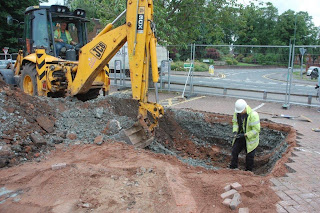 |
| Site chief Richard Bradley directs the machining |
Last week, we marked out the area to be excavated, then removed the modern deposits associated with the Market Hall and car park with a JCB. The machining was directed by Richard Bradley, the archaeologist in charge of the excavation.
It may sound strange to start a delicate and painstaking archaeological dig with a big mechanical excavator, but with a skilled driver and careful supervision, it is possible to remove very precise layers of material by machine. This Youtube video is a great demonstration, as Time Team's star digger driver Ian Barclay peels a banana using an excavator! As soon as we reached the archaeological deposits underneath the modern levels, the machine stopped and we awaited the arrival of our volunteers.
 |
| The site, machined and ready to be cleaned |
The 'clean' is essential because before we start 'digging' down through the deposits, we need to have a clear idea of what we're looking at across the site. It will help us to start to think about the relationships between the different phases of archaeology and features across the site, and to plan which layers we'll excavate first.
After the first day, the site is already looking a lot cleaner, and the features and deposits are starting to appear as our hard-working volunteers toil away in the sweltering heat.
 |
| Our Volunteers giving a lovely demonstration of good trowel-cleaning |
Rob Hedge
No comments:
Post a Comment